
August Willem van Voorden (25 November 1881, Rotterdam - 2 October 1921, Rotterdam) was a Dutch painter, best known for scenes of urban life in his hometown.

August Willem van Voorden (25 November 1881, Rotterdam - 2 October 1921, Rotterdam) was a Dutch painter, best known for scenes of urban life in his hometown.
His father was a decorative house painter and gave him his first lessons. His first formal studies were at the Academy of Visual Arts. Later, he took lessons from Alexander van Maasdijk and Jan de Jong . [1] He spent most of his life in Rotterdam, where he had a studio on the grounds of the Woudestein Estate (now part of Erasmus University). In 1908, he lived briefly in Kortenhoef, where he met his wife, and from 1912 to 1913 he was in Nieuw-Loosdrecht. [1]
He initially worked as a decorative painter, like his father, but after 1903 began doing regular oils and watercolors depicting street scenes, filled with the daily activities of ordinary people. He was heavily influenced by the works of George Hendrik Breitner and was often referred to as the "Breitner of Rotterdam". [2]
He worked during a period of rapid growth and was able to document the process, choosing bright, impressionistic colors as a counterweight to the gray hues normally associated with Dutch cityscapes. He also painted landscapes near Kortenhoef and Laren, where he worked with artists of the Hague School, as well as some portraits and still-lifes. For many years, he was a member of Arti et Amicitiae and the Haagse Kunstkring. [1] He died of undisclosed causes just short of his fortieth birthday.
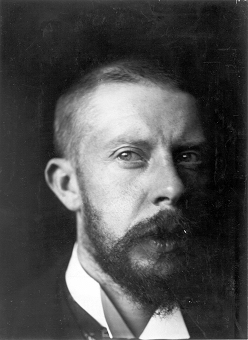
George Hendrik Breitner was a Dutch painter and photographer. An important figure in Amsterdam Impressionism, he is noted especially for his paintings of street scenes and harbours in a realistic style. He painted en plein air, and became interested in photography as a means of documenting street life and atmospheric effects – rainy weather in particular – as reference materials for his paintings.

Adriaen van de Velde, was a Dutch painter, draughtsman and print artist. His favorite subjects were landscapes with animals and genre scenes. He also painted beaches, dunes, forests, winter scenes, portraits in landscapes, as well as mythological and biblical scenes. He belongs to a group of painters referred to as the Dutch Italianate painters, who combined Dutch agricultural landscapes with mythological or Arcadian scenes in Italian settings. His paintings are characterised by their delicate, careful composition and his mastery of lighting effects as well as the human figure.

The Hague School is a group of artists who lived and worked in The Hague between 1860 and 1890. Their work was heavily influenced by the realist painters of the French Barbizon school. The painters of the Hague school generally made use of relatively somber colors, which is why the Hague School is sometimes called the Gray School.

Simon de Vlieger was a Dutch painter, draughtsman and designer of tapestries, etchings, stained glass windows. While he is mainly known for his marine paintings he also painted beach scenes, landscapes and genre scenes.

Wilhelmus "Willem" Hendrikus Petrus Johannes de Zwart was a Dutch painter, engraver, and watercolorist with many connections to the Hague School and later associated with the Amsterdam Impressionism movement.

Isaac Lazarus Israëls was a Dutch painter associated with the Amsterdam Impressionism movement.

Amsterdam Impressionism was an art movement in late 19th-century Holland. It is associated especially with George Hendrik Breitner and is also known as the School of Allebé.

Dutch art describes the history of visual arts in the Netherlands, after the United Provinces separated from Flanders. Earlier painting in the area is covered in Early Netherlandish painting and Dutch and Flemish Renaissance painting.
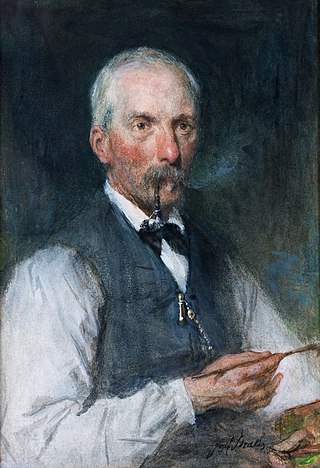
Jan Hendrik Weissenbruch, also known as Hendrik Johannes Weissenbruch was a Dutch painter of the Hague School. He is noted especially for his watercolours.

The Willem de Kooning Academy is a Dutch academy of media, art, design, leisure and education based in Rotterdam. It was named after one of its most famous alumni, Dutch fine artist Willem de Kooning.

Willem Arnoldus Witsen was a Dutch painter and photographer associated with the Amsterdam Impressionism movement.
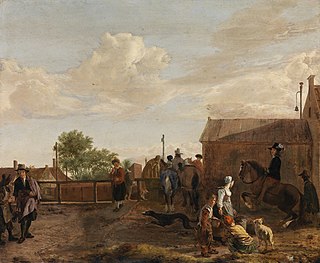
Ludolf de Jongh or Ludolf Leendertsz. de Jongh was a Dutch painter, known for his genre scenes, hunting scenes, history paintings, landscapes, cityscapes and portraits. He was further a merchant, an officer in the civil guard of Rotterdam and a schout (sheriff) of Hillegersberg. He was in the 1650s the leading genre painter in Rotterdam whose work influenced artists such as Pieter de Hooch. He was active as a staffage painter and added the figures in the works of artists such as the church interior painter Anthonie de Lorme and the landscape painter Joris van der Haagen.
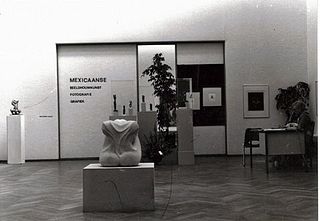
Pulchri Studio is a Dutch art society, art institution and art studio based in The Hague ('s-Gravenhage), Netherlands.
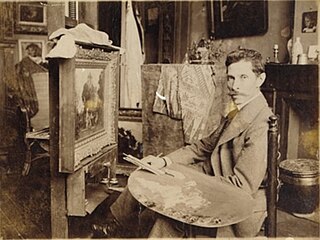
Johannes Evert Hendrik Akkeringa was part of the second generation of the Hague School painters. Akkeringa is primarily known for his paintings and watercolours of women and playing children at the beach, women mending nets and intimate tea-time conversations.

Paul Joseph Constantin Gabriël or Paul Gabriël was a painter, draftsman, watercolorist, and etcher who belonged to the Hague School.

Floris Hendrik Verster was a Dutch painter.
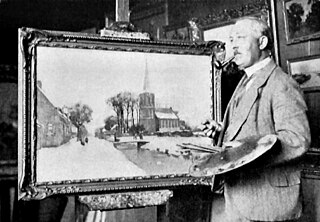
Bernardus Antonie van Beek was a Dutch landscape painter. He never attended an academy. He was part of the Kortenhoef School, a sub-movement of the Hague School and is thus in the tradition of Barbizon School. From his choice of motifs, there are also influences of the Amsterdam Impressionism. His work was part of the painting event in the art competition at the 1928 Summer Olympics.
The Laren School is the name of an art colony located in the Dutch village, Laren, in the Gooi near Hilversum. The artists of this offshoot of the Hague School chose the inhabitants of Laren and the surrounding landscape as the subject of their art.

Ahazueros Jacobus Breman, known as Co was a Dutch painter. He specialized in landscapes, farms and interior scenes, with figures, and was one of the first Pointillist painters in the Netherlands.
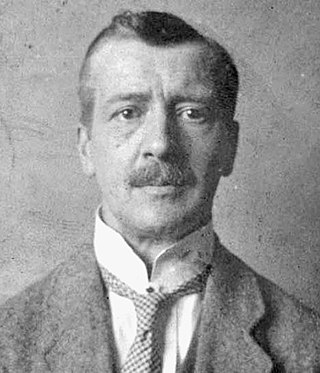
Hermanus Willem Koekkoek was a Dutch painter, illustrator and watercolorist. He worked in several genres, but is best known for his military art.